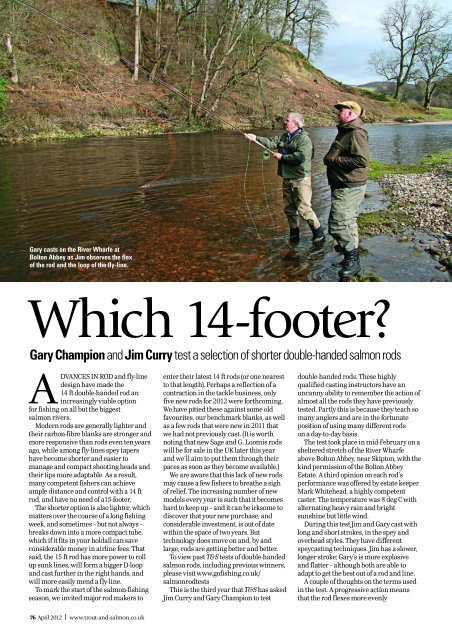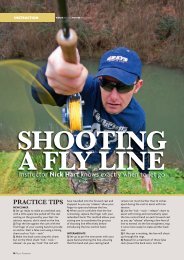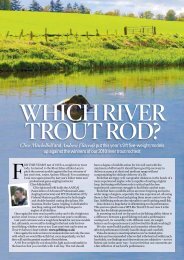download the PDF. - Greys Fishing
download the PDF. - Greys Fishing
download the PDF. - Greys Fishing
You also want an ePaper? Increase the reach of your titles
YUMPU automatically turns print PDFs into web optimized ePapers that Google loves.
Heading<br />
Gary casts on <strong>the</strong> River Wharfe at<br />
Bolton Abbey as Jim observes <strong>the</strong> flex<br />
of <strong>the</strong> rod and <strong>the</strong> loop of <strong>the</strong> fly-line.<br />
Which 14-footer?<br />
Gary Champion and Jim Curry test a selection of shorter double-handed salmon rods<br />
Advances in rod and fly-line<br />
design have made <strong>the</strong><br />
14 ft double-handed rod an<br />
increasingly viable option<br />
for fishing on all but <strong>the</strong> biggest<br />
salmon rivers.<br />
Modern rods are generally lighter and<br />
<strong>the</strong>ir carbon-fibre blanks are stronger and<br />
more responsive than rods even ten years<br />
ago, while among fly-lines spey tapers<br />
have become shorter and easier to<br />
manage and compact shooting heads and<br />
<strong>the</strong>ir tips more adaptable. as a result,<br />
many competent fishers can achieve<br />
ample distance and control with a 14 ft<br />
rod, and have no need of a15-footer.<br />
The shorter option is also lighter, which<br />
matters over <strong>the</strong> course of a long fishing<br />
week, and sometimes – but not always –<br />
breaks down into a more compact tube,<br />
which if it fits in your holdall can save<br />
considerable money in airline fees. That<br />
said, <strong>the</strong> 15 ft rod has more power to roll<br />
up sunk lines, will form a bigger d-loop<br />
and cast fur<strong>the</strong>r in <strong>the</strong> right hands, and<br />
will more easily mend a fly-line.<br />
To mark <strong>the</strong> start of <strong>the</strong> salmon-fishing<br />
season, we invited major rod makers to<br />
enter <strong>the</strong>ir latest 14 ft rods (or one nearest<br />
to that length). Perhaps a reflection of a<br />
contraction in <strong>the</strong> tackle business, only<br />
five new rods for 2012 were forthcoming.<br />
We have pitted <strong>the</strong>se against some old<br />
favourites, our benchmark blanks, as well<br />
as a few rods that were new in 2011 that<br />
we had not previously cast. (it is worth<br />
noting that new sage and G. Loomis rods<br />
will be for sale in <strong>the</strong> UK later this year<br />
and we’ll aim to put <strong>the</strong>m through <strong>the</strong>ir<br />
paces as soon as <strong>the</strong>y become available.)<br />
We are aware that this lack of new rods<br />
may cause a few fishers to brea<strong>the</strong> a sigh<br />
of relief. The increasing number of new<br />
models every year is such that it becomes<br />
hard to keep up – and it can be irksome to<br />
discover that your new purchase, and<br />
considerable investment, is out of date<br />
within <strong>the</strong> space of two years. But<br />
technology does move on and, by and<br />
large, rods are getting better and better.<br />
To view past T&S tests of double-handed<br />
salmon rods, including previous winners,<br />
please visit www.gofishing.co.uk/<br />
salmonrodtests<br />
This is <strong>the</strong> third year that T&S has asked<br />
Jim curry and Gary champion to test<br />
double-handed rods. These highly<br />
qualified casting instructors have an<br />
uncanny ability to remember <strong>the</strong> action of<br />
almost all <strong>the</strong> rods <strong>the</strong>y have previously<br />
tested. Partly this is because <strong>the</strong>y teach so<br />
many anglers and are in <strong>the</strong> fortunate<br />
position of using many different rods<br />
on a day-to-day basis.<br />
The test took place in mid-February on a<br />
sheltered stretch of <strong>the</strong> river Wharfe<br />
above Bolton abbey, near skipton, with <strong>the</strong><br />
kind permission of <strong>the</strong> Bolton abbey<br />
estate. a third opinion on each rod’s<br />
performance was offered by estate keeper<br />
Mark Whitehead, a highly competent<br />
caster. The temperature was 8 deg c with<br />
alternating heavy rain and bright<br />
sunshine but little wind.<br />
during this test Jim and Gary cast with<br />
long and short strokes, in <strong>the</strong> spey and<br />
overhead styles. They have different<br />
speycasting techniques. Jim has a slower,<br />
longer stroke; Gary’s is more explosive<br />
and flatter – although both are able to<br />
adapt to get <strong>the</strong> best out of a rod and line.<br />
a couple of thoughts on <strong>the</strong> terms used<br />
in <strong>the</strong> test. a progressive action means<br />
that <strong>the</strong> rod flexes more evenly<br />
76 April 2012 www.trout-and-salmon.co.uk
Gary Champion<br />
Cornwall-based Gary<br />
has fly-fished for 40<br />
years and became a<br />
casting instructor<br />
13 years ago. He<br />
holds <strong>the</strong> AAPGAI<br />
Master qualification<br />
in all disciplines and<br />
is part of <strong>the</strong> AAPGAI<br />
assessment team.<br />
He also holds <strong>the</strong><br />
American FFF Master<br />
instructor qualification<br />
and fishes for salmon<br />
in <strong>the</strong> UK, Ireland,<br />
Canada, Iceland,<br />
Spain and America.<br />
Jim Curry<br />
Jim is a fly-fishing<br />
instructor from Ilkley,<br />
Yorkshire and partner<br />
in <strong>the</strong> Halstead and<br />
Bolton Sporting<br />
Agency. He has<br />
taught fly-casting for<br />
more than 20 years<br />
and is an AAPGAI<br />
Master instructor<br />
and part of <strong>the</strong><br />
AAPGAI assessment<br />
team. Jim fishes for<br />
salmon and sea-trout<br />
throughout <strong>the</strong> UK,<br />
plus Iceland, Norway<br />
and Argentina.<br />
Airflo Airlite<br />
Nan-Tec<br />
£289.99<br />
A three-piece 9/10-weight rod<br />
with overfit joints. Natural<br />
carbon blank and black<br />
whippings. Two stripping<br />
rings, nine snake intermediate<br />
rings and a hayfork tip ring.<br />
23 in cork/composite cork<br />
handle. Downlocking screw<br />
reel fitting with two locking<br />
nuts. Keeper ring. Cloth bag<br />
and cloth-covered tube with<br />
handle and carrying strap.<br />
Guideline Exceed<br />
(13 ft 7 in)<br />
£289.99<br />
A four-piece 9/10-weight rod<br />
with overfit joints. Olive blank<br />
and whippings. Two stripping<br />
rings, nine snake intermediate<br />
rings and a hayfork tip ring.<br />
21 in cork/EVA handle.<br />
Downlocking screw reel fitting<br />
with two locking nuts. No<br />
keeper ring. Cloth bag and<br />
cloth-covered tube with<br />
carrying strap.<br />
throughout its length, gradually<br />
bending into <strong>the</strong> butt section as force is<br />
increasingly applied. A tip action means<br />
that most of <strong>the</strong> flex occurs in <strong>the</strong> rod’s tip<br />
and <strong>the</strong> lower section doesn’t flex easily.<br />
Generally, <strong>the</strong> progressive action is<br />
favoured as it is most likely to be able to<br />
cast lines of all types: from short<br />
shooting head to full sinker.<br />
With <strong>the</strong> proliferation of salmon<br />
fly-lines in recent years (shootings heads,<br />
skagits, multi-tips and spey tapers of<br />
many different lengths), our testers<br />
believe, in common with many o<strong>the</strong>r rod<br />
designers and casting experts, that AFTM<br />
line-weight ratings have limited use when<br />
matching <strong>the</strong> correct line to a doublehanded<br />
rod. There is simply far too<br />
much variation in <strong>the</strong> casting weights<br />
of different lines that share <strong>the</strong> same<br />
AFTM line rating.<br />
A more accurate rod rating, <strong>the</strong>y<br />
argue, is for fly-line head weights to be<br />
measured in grams or grains, which<br />
though more elaborate, ensures a better<br />
match – surely desirable given <strong>the</strong><br />
cost of modern lines.<br />
The lines used in this test were:<br />
speylines – Carron Jetstream 65 ft<br />
10 wt and 65 ft 9 wt; shooting heads –<br />
Rio AFS 38 gram, MacKenzie DTX 42<br />
gram, and Guideline Shortcut DC hover/<br />
intermediate 36 gram, each with Airflo<br />
Ridge Extreme 30 lb running line;<br />
sinking line – Snowbee Scandinavian<br />
Spey ultra fast sink, 40 gram.<br />
To be a true all-rounder and alternative<br />
to <strong>the</strong> 15-footer, <strong>the</strong> 14 ft rods must be able<br />
to roll up a full sinking line.<br />
GAry’s comments<br />
This rod has a progressive action. It is<br />
perhaps a little stiff for my taste<br />
but flexes deeply down <strong>the</strong><br />
blank and recovers quickly.<br />
It coped with all <strong>the</strong> lines we tried,<br />
whe<strong>the</strong>r shorter, gentler casts or more<br />
aggressive strokes. It feels nice in <strong>the</strong><br />
hand; balanced. A nice cork handle and<br />
matt-black finish. There’s only one<br />
drawback: it’s a three-piece rod and<br />
<strong>the</strong>refore less portable.<br />
Jim’s comments<br />
I would be very happy to fish with this. It<br />
is very user-friendly, comfortable to cast<br />
and I would recommend it to my clients.<br />
You don’t have to work hard or fight it like<br />
you do with some rods. I can create nice<br />
tight loops and I can be accurate and<br />
precise in <strong>the</strong> delivery. It is good with all<br />
<strong>the</strong> lines, although may lack just a little<br />
power with <strong>the</strong> sinker.<br />
I like <strong>the</strong> slim handle.<br />
Airflo<br />
tel: 0871-911-7045;<br />
web: www.airflofishing.com<br />
GAry’s comments<br />
The Exceed is not as tippy as previous<br />
Guideline rods. It’s a nice rod but I get on<br />
best with it when I leng<strong>the</strong>n and slow<br />
down my stroke. I don’t like it as much as<br />
Jim does, although with it I can still cast<br />
a good long line with nice loops. When I<br />
try a shorter stroke normally associated<br />
with a shooting head I get a bit of bounce<br />
in <strong>the</strong> tip section. It is very good with <strong>the</strong><br />
sinking line, probably because <strong>the</strong> longer<br />
stroke required smoo<strong>the</strong>s things out.<br />
RECOMMENDED<br />
Jim’s comments<br />
This rod fits me like a glove. I liked it<br />
instantly. It suits my longer stroke.<br />
Accelerate smoothly and don’t push it too<br />
hard. It’s responsive and offers plenty of<br />
feel. I was able to create nice loops with<br />
<strong>the</strong> spey lines and it was equally good<br />
with <strong>the</strong> shooting heads. Rolling up <strong>the</strong><br />
sinker was effortless.<br />
Guideline<br />
tel: 0780-2508-483;<br />
web: www.guideline.no.en<br />
www.trout-and-salmon.co.uk April 2012 77






